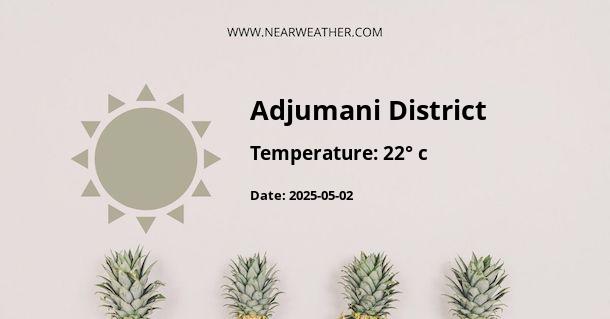Climate and Weather in Adjumani District, Uganda
Located in northern Uganda, Adjumani District experiences a tropical climate with distinct wet and dry seasons. The district is situated near the border with South Sudan, and its climate is influenced by the nearby mountains and the presence of the Nile River. Understanding the weather patterns and climate of Adjumani District is essential for residents, tourists, and researchers alike. Let's explore the weather conditions and climate throughout the year in Adjumani District.
Temperature
Adjumani District has a relatively consistent temperature throughout the year, with little variation between seasons. The average annual temperature in the district is around 27 degrees Celsius (81 degrees Fahrenheit). However, temperatures can reach up to 35 degrees Celsius (95 degrees Fahrenheit) during the hottest months.
The hottest period in Adjumani District occurs between December and February, which is the dry season. During this time, temperatures can be quite high, especially during the day. The average maximum temperature during these months is around 33 degrees Celsius (91 degrees Fahrenheit). It is important to stay hydrated and take necessary precautions to avoid heat-related illnesses during this period.
On the other hand, the coolest months in Adjumani District are between June and August, which is the wet season. During this time, the average minimum temperature drops to around 20 degrees Celsius (68 degrees Fahrenheit). Although the temperatures are relatively cooler, the humidity remains high, creating a pleasant and comfortable environment.
Rainfall
Adjumani District experiences a bimodal rainfall pattern, with two distinct rainy seasons throughout the year. The first rainy season, known as the "long rains," occurs from March to June. This period receives the highest amount of rainfall in the district, with an average of 800-1000 millimeters (31-39 inches) of rain. The rain is essential for agriculture and contributes to the fertility of the soil in the region.
The second rainy season, known as the "short rains," occurs from September to November. During this period, the district receives a relatively lower amount of rainfall compared to the long rains. The average rainfall during the short rains ranges from 400-600 millimeters (16-24 inches).
The dry season in Adjumani District lasts from December to February and also from July to August. These months experience minimal or no rainfall, making them ideal for outdoor activities and exploration. However, it is important to note that even during the dry season, there may be occasional showers or thunderstorms.
Wind Patterns
The wind patterns in Adjumani District are influenced by the geographical location and surrounding topography. The prevailing winds in the district are the northeast trade winds. These winds blow from the northeast direction, bringing moisture from the Nile River and Lake Albert. The winds contribute to the rainfall patterns and help regulate the overall climate of the region.
During the dry season, the winds are generally calm and have minimal impact on the weather conditions. However, during the rainy seasons, the winds can pick up, leading to occasional gusts and stronger breezes. These winds are crucial for dispersing seeds, pollination, and the overall ecosystem of the district.
Climate Hazards
While Adjumani District generally experiences favorable weather conditions, there are some climate hazards to be aware of. Flooding is one of the main hazards during the rainy seasons. Heavy rainfall can cause rivers and streams to overflow, leading to flooding in low-lying areas. It is important to stay updated with weather forecasts and take necessary precautions to ensure personal safety during these periods.
Another climate hazard in the district is drought. During prolonged dry spells, water scarcity can become an issue, affecting agriculture and the livelihoods of the local communities. Efforts are being made to implement sustainable water management practices and improve water storage facilities to mitigate the impact of drought.
Conclusion
Adjumani District, Uganda, has a tropical climate with distinct wet and dry seasons. The district experiences relatively consistent temperatures throughout the year, with the hottest period occurring from December to February and the coolest months between June and August. The bimodal rainfall pattern brings the long rains from March to June and the short rains from September to November. It is important to be aware of climate hazards such as flooding and drought and take necessary precautions. Understanding the climate and weather patterns in Adjumani District is crucial for planning activities, agriculture, and overall preparedness.
A - Adjumani District's Latitude is 3.250000 & Longitude is 31.750000.
A - Weather in Adjumani District is 33° today.
A - Climate Conditions in Adjumani District shows few clouds today.
A - Humidity in Adjumani District is 29% today.
A - Wind speed in Adjumani District is 1.8 km/h, flowing at 47° wind direction. today.
